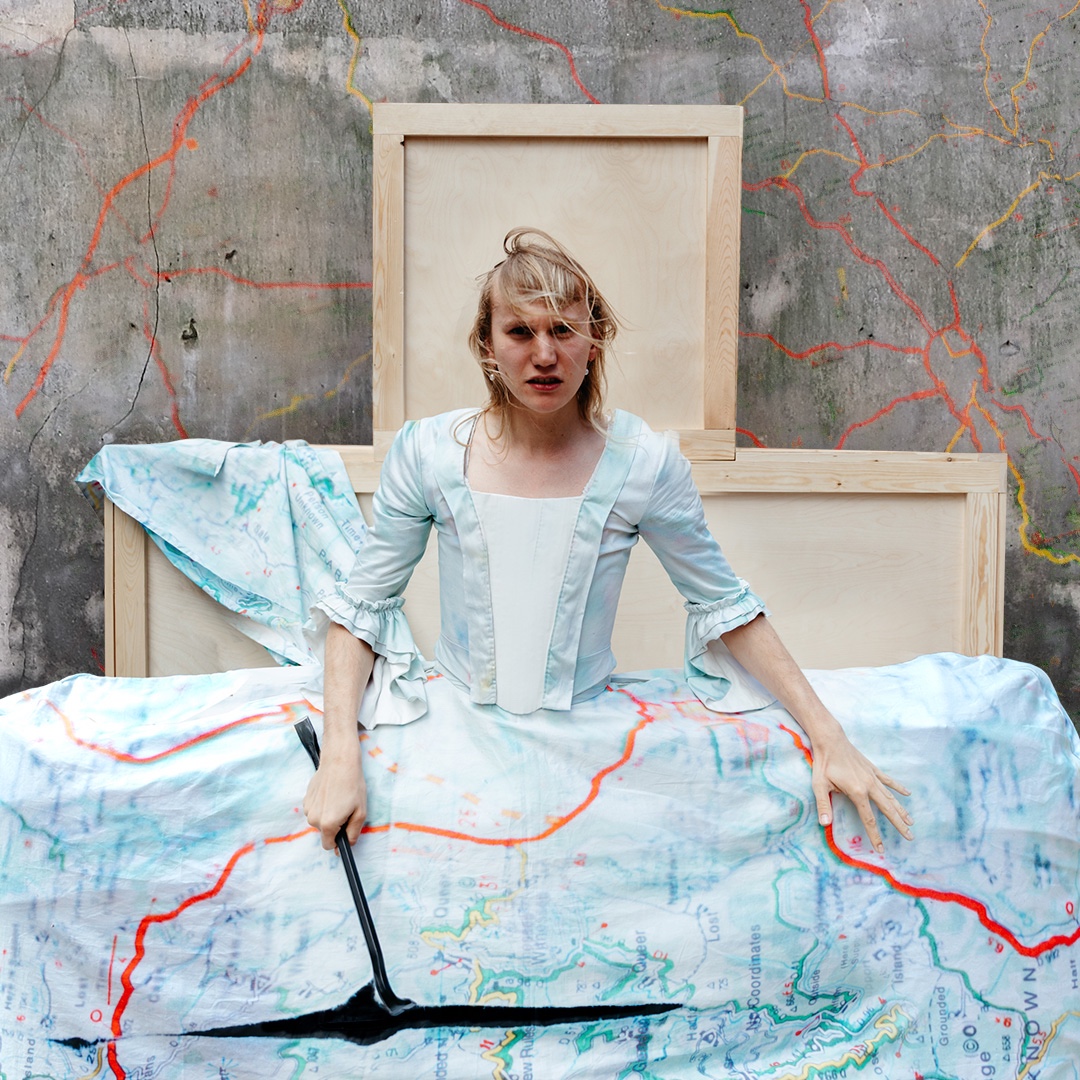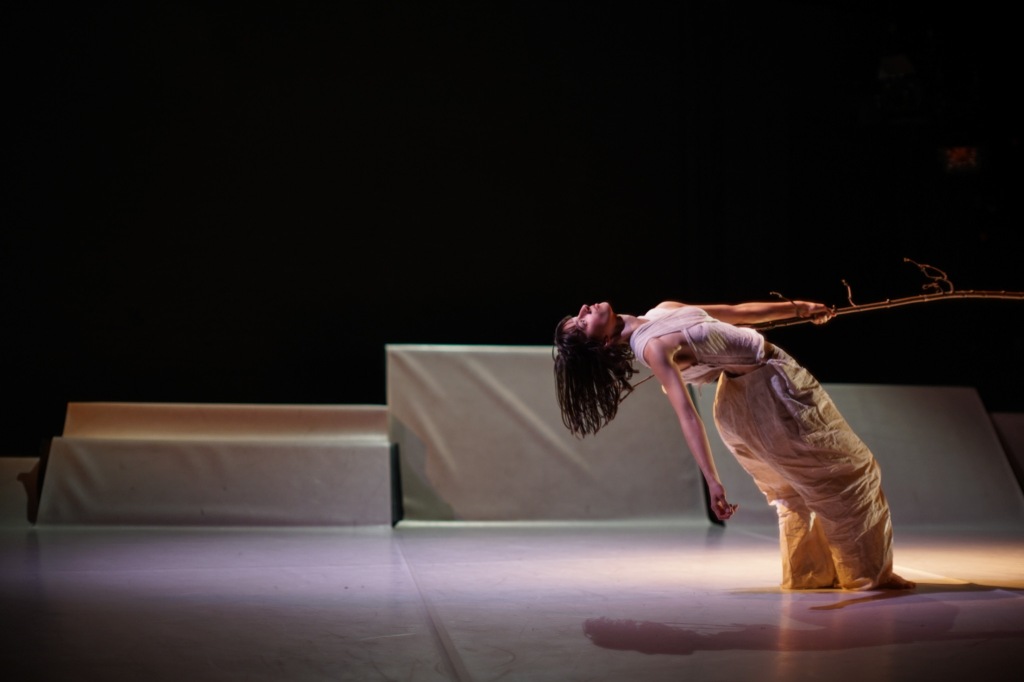Words by Francesca Matthys. Mapping Gender was performed at The Place in September 2022.
Mapping Gender by Anders Duckworth in collaboration with sound artist Kat Austen—is a beautifully tailored piece of performance art/dance theatre that entices the senses and maps both a personal and historical story of gender.
The story begins in the theatre foyer, even before the actual performance, through an exhibition of Duckworth’s process and research. Photographs, quotes, videos, punch needle art and images. This thoughtfully curated tapestry created a curious foundation for what we were to witness.
As the audience entered the performance space that had been completely stripped of any wings, the seating arrangement of the theatre had been extended to accommodate watching from the sides. This exposed the performance space that held large wooden boxes stacked as if they were in a warehouse. A liminal space where objects are held in transit. In these boxes perhaps one’s identity is hidden, packed up to be taken away or ready to be opened, shown. To come out.

The bare space and the DJ/sound desk positioned stage left evoked feelings of being in a nightclub or a ballroom space, offering a potentially more intimate connection to the performer.
After a prolonged silence, an unlocked latch and the sounds of physical struggle and scuffling amplified through a microphone, a hand with glistening ‘burnt Sienna’ nails gently rested on the edge of one of the boxes. This, our first clue of the performer, a first in flesh taste of what is expected. Poised and prim yet cautious of what awaits them.
This tone soon shifted as we were witness to a cold and hard object that looked like a crowbar. The violent connotations immediately made my body quiver as thoughts of the many injustices experienced by queer bodies reverberated through the space. The sensitivity through which the object was handled allowed its purpose to translate in and out of both harm and protection; of both self and other.
“Duckworth’s choice to conceal their body as if it were an unfamiliar, foreign object as well as label their body as unknown is an impactful and harsh representation on the way that non-binary bodies are in many spaces still seen as ‘other’”
Duckworth’s full body was soon displayed to us in what looked like a white hazmat suit made famous during the beginning of the Covid-19 outbreak. Protecting its contents. As it is carefully unzipped, Duckworth’s body was adorned in an extravagantly designed Rococo style dress famously worn in the 18th century by Marie Antoinette. Like a barbie out of a box. As Duckworth danced closer towards us the intricate lines of a unique map, including landmarks like ‘parts unknown’ were illuminated.
Duckworth’s choice to conceal their body as if it were an unfamiliar, foreign object as well as label their body as unknown is an impactful and harsh representation on the way that non-binary bodies are in many spaces still seen as ‘other’, not fitting into ‘conventional’ gender categories. The many borders that informed the piece. And the map; a tool for a process of discovery. In the post performance discussion, the creative team highlighted the importance of maps in the work and mentioned maps that are both oppressive and empowering in allowing one to share more about oneself.
The work is informed by thoughtful conversations had with non-binary individuals who have consented to sharing their stories. In the post performance discussion, dramaturg Emma Frankland mentioned that the work is held by the community rather than a representation of it. This community of voices were layered through the rich performance score. The spirits of these many individuals, divulged their opinions on borders and what it meant to exist in their bodies. This was the score as Duckworth moved from coyly sashaying across the stage to sword fighting on tiptoes and of course contorting their face into a silent scream while holding up the crow bar-like object above their head. This poignant image reminded me of Hitchcock’s haunting shower scene, though Duckworth’s version subverted this, resembling both victim and perpetrator. Duckworth was soon swept away, through dynamic whirlwind movements, by the sea of gender perceptions and binaries that dictate gender privilege. Another voice questions who is allowed leisurely walks; men in suits and woman in dresses. A ruthless polarity that has been infiltrated through our humanness.

Duckworth’s playful use of scenic devises allows the words ‘Gender playground’ to rest in the foreground of my mind. How are we able to be playful with our gender expression?
Their use of an array of scenic devices from boxes to ropes, to costume pieces to crowbars paints both beautiful and harrowing illustrations for us as watchers. We are witness to the body of the dress becoming a horse, a more dated yet still present mode of transportation. Transportation as a liminal experience becomes a metaphor in the work for the journey of many individuals who exist on the outskirts of ‘gender norms’. Though Duckworth’s exploration allows us to travel towards a place of reparation and resilience as it develops.
We watch as the bright orange string, inspired by the colour of the routes on the map, is retched out as if Duckworth were sea sick, purging old ideas of gender or ill as a result of them. The research around liminal, natural landscapes is a large part of the work in both its imagery and soundscapes. Water and the sea specifically as a powerful and immense body, both disturbs the performer’s body but can also be seen as a metaphor for the depth and magnitude of this subject matter. As we are more than 70% water it may also be seen as a metaphor for the self, the non binary body that is waved through a tumultuous existence of becoming and acceptance.
“The juxtaposition of what is shown and hidden in costume is a smart and very clear commentary on not belonging to one polarity but choosing to exist in-between spaces.”
As Duckworth begins to undress, the many layers of their costume are exposed that include a very restrictive corset that reminded me of the practice of ‘chest binding’ where a trans individual will compress their breast tissue with tight clothing, bandages or a binder to create a flat chest. As Duckworth sat with their back towards us they very carefully untied the ribbons that held their chest tightly together. The care in this action conjured up thoughts of the emphasis of care that is needed to be shown for non-binary bodies navigating the world. As Duckworth undresses they also expose their knee high socks and pink 18th century shoes that have been mostly hidden until now. The juxtaposition of what is shown and hidden in costume is a smart and very clear commentary on not belonging to one polarity but choosing to exist in-between spaces.
Before the final moments of the work, Duckworth now, stripped down to a white 18th century nighty almost like an embodied surrender, drinks water from a bottle and pores some into a makeshift bath created from one of the boxes. This act is synonymous with that of the often African practice of libation where one pores liquid or grains in recognition of one’s ancestors. Whether conscious or not, it is a moment of awareness for those that have began the fight for queer rights across the globe and those that are to come, those that are here like Anders Duckworth. This sentiment echoes the words of those in the space with Duckworth; ’My existence is activism’.

Throughout this important and sensitively loaded work we are reminded of the journey that is filled with not only joy, self appreciation, playfulness but mourning as we see the crinoline dress structure mimic a dead carcass and Duckworth’s body displayed in a crucifixion pose. We swiftly move through these various moments as if we are in a fever dream, afraid to look but also afraid to miss out.
The impossible nature of mapping gender as mentioned by the creative team is exactly what the work tackles. The creative team once again mentioning that ‘…sometimes we need to map our gender to communicate…’. Duckworth as a performer is a strong and present and ultimately the work offers an intentionally highly physical experience of how non-binary bodies and anyone who experiences themselves on the boundaries may dig deep, excavate and land on fertile soil in their own journeys of self discovery.
Choreographer /Performer: Anders Duckworth
Sound Artist: Kat Austen
Designer: Kit Hinchliffe
LX Designer: Martha Godfrey
Dramaturg: Emma Frankland
Costume Designer: Nadia Miah
Costume Makers: Nadia Miah & Laura Rose Moran-Morris
Scent Artist: John Foley
Outside Eye: Ania Varez
Imagery: Rosie Powell & Guy J Sanders
Producers: Reece McMahon & Emily Beecher, The REcreate Agency






